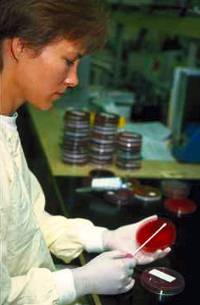8 March 2000
Bugs that make hearts less stressed
by Kate Melville
 Having heart failure is one of the leading causes of death in developed countries. While this seems to be fairly directly inked to our increasingly sedentary, high stress lifestyles, researchers are always looking in every direction for things that might reduce our death rate from cardiac failure.
Having heart failure is one of the leading causes of death in developed countries. While this seems to be fairly directly inked to our increasingly sedentary, high stress lifestyles, researchers are always looking in every direction for things that might reduce our death rate from cardiac failure.
In one of the more unusual avenues of cardiac research Calvin Hale a scientist from the University of Missouri-Columbia has found a very unlikely hero in heart research methodology - the cabbage looper caterpillar.
Using the loper caterpillar, Hale has been able to create a protein found in the heart which is causes for muscle relaxation. By working out how to stop this protein relaxing the heart may be a way to save thousands of lives.
"Before, we had to grow the protein in petri dishes and it was very time consuming," Hale said. "It would take quite a long time and even then, we would get a very small amount. Now, with just one caterpillar, we are able to get more protein than we could grow in ten petri dishes in a much faster time. This allows us to study the protein at much greater levels, closer to what is found in the heart."
As we all know the human heart is either constricting or relaxing. To begin the process, calcium is taken into the heart and then as the calcium level rises, the heart begins to contract. To reverse this and to relax, calcium must be moved out of the heart. This is achieved by a special protein which exchanges sodium for calcium and in doing so the heart relaxes.
In healthy hearts, the process of contraction and relaxation happens at regular intervals, but in patients with heart failure, the heart lacks tone and tends to relax for too long. This problem has been well known for many years, but scientists have not been able to produce the protein in sufficient quantities to progress a potential cure.
Hale's new technique involves injecting caterpillars with a genetically altered virus, the baculovirus that is not dangerous to humans. The virus spread throughout the caterpillar's body and produce the exchanger protein, which is then harvested.
However actually getting the protein from the membranes that cover the heart proved impossible with standard techniques, so Hale's team developed a new method that purified the membranes, making harvesting the protein possible (they have harvested the membranes from more than 1500 caterpillars so far).
According to Hale, "We took a known technique and went one step further with it. By developing this purification technique, it allowed us to use the caterpillars and harvest the protein. The use of these little bugs will enable us to move more quickly to develop a drug that will help with congestive heart failure."
Hale and other scientists are now trying to crystallise the protein, which if successful will make the structure much more evident and improve chances of designing a drug that reduces cardiac relaxation.
